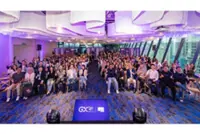Dr Ong (second from right) posing with primary school students and teachers at SJK(C) Chung Hua Port Dickson after a robotic arm workshop.
THE Academy of Sciences Malaysia has highlighted that nine out of the top 10 emerging jobs in 2025 are science, technology, engineering and mathematics (STEM) related.
Despite this trend shift, interest in STEM education continues to dwindle, as students opt to steer away from taking these subjects.
Universiti Tunku Abdul Rahman (UTAR) STEM Outreach head Dr Ong Kiah Ju believes that the lack of experiential learning is a key factor in this, as merely “learning from books” is not enough to stimulate or cultivate interest in STEM education.
“I think that children are not really interested in subjects related to science and technology because they can’t see the connection between the knowledge they learn and how STEM principles are applied to it,” she says.
“There has to be more examples of how STEM is applied in daily life – its application. If students can see the linkage, they might develop more of an understanding and interest in it.”
Dr Ong, who has been a lecturer at UTAR for the past 11 years, says that this is one of the main reasons that UTAR’s STEM Outreach division focuses on fostering interest in science and technology.
The STEM Outreach division organises hands-on workshops, talks, webinars, training sessions and more – all related to promoting and cultivating interest in STEM education.
Dr Ong shares that UTAR’s STEM Outreach representatives even make visits to schools, colleges and universities to plan, coordinate and organise interactive STEM activities such as flying drones, insect pinning, using 3D printers, dissecting goat hearts and using robotic arms.
“We actually plan and organise activities for school students all the time. We will approach schools and see what their needs are, and how we can do something like having a STEM workshop for them,” says Dr Ong.
“We want to expose students to science experiments and projects, so that they know how interesting STEM can be.
“This is why we use many types of technologies to improve the learning experience as it is totally different when you have the technology or equipment right in front of you.
“It’s very difficult for the students to relate until they see or experience the real thing. When they do these kinds of activities, they actually ‘learn by doing’, that’s why our programmes are more skewed towards hands-on activities.”
Apart from school visits, UTAR also aims to promote STEM education via the Kuala Lumpur Engineering and Science Fair (KLESF) 2023, which will be held at the Mines International Exhibition and Convention Centre (MIECC) from Oct 27 to 29.
KLESF was first launched 10 years ago in a bid to promote STEM among primary and secondary school students, but is now open for the public as well.
The KLESF partners comprise the Asean Academy of Engineering and Technology (AAET), Institution of Engineers Malaysia (IEM), Malaysian Industry-Government Group for High Technology (MIGHT), Malaysian Invention and Design Society (MINDS), Tunku Abdul Rahman University University of Management and Technology (TAR UMT) and UTAR.
Dr Ong shares that she hopes to build more collaborations through initiatives such as KLESF, to amplify STEM education awareness.
“We welcome anyone and everyone to collaborate with us to promote STEM. The purpose is to enhance the students’ interest in STEM, and to create more awareness to the public as well, to let them know how important STEM is in the development and sustainability of the country,” she says.
“Through events like KLESF, we wish to pull different organisations and industries together to form a platform for everyone to promote STEM. It will provide a networking platform for educators, industry professionals, universities, schools and the public to come and share their knowledge of STEM.”
KLESF places an emphasis on hands-on experiences and activities for students and teachers alike, which could complement school curriculums.
Under KLESF, UTAR also carries out a number of other STEM-related programmes targeted at students, parents and teachers, such as KLESF Mentor Development Programme (KMD), KLESF Mentorship Programme (KMP), KLESF STEM Educator Enhancement Programme (KSEEP) and KLESF STEM Workshop (KSW).
Dr Ong states that these programmes also help to improve the delivery of STEM education.
Under KMD, for example, teachers and educators are trained to come up with creative solutions to make activities and exercises more stimulating for students, while KMP trains UTAR students to become mentors that carry out the experiments with school students.
UTAR currently has five different faculties related to STEM which are the M. Kandiah Faculty of Medicine and Health Sciences, Lee Kong Chian Faculty of Engineering and Science, Faculty of Engineering and Green Technology, Faculty of Information and Communication Technology and Faculty of Science.
To find out more about KLESF 2023, visit.
For more information on the STEM programmes offered at UTAR, visit.








